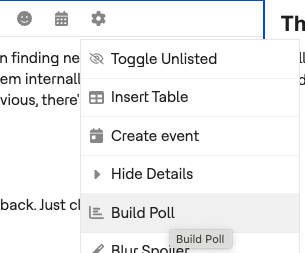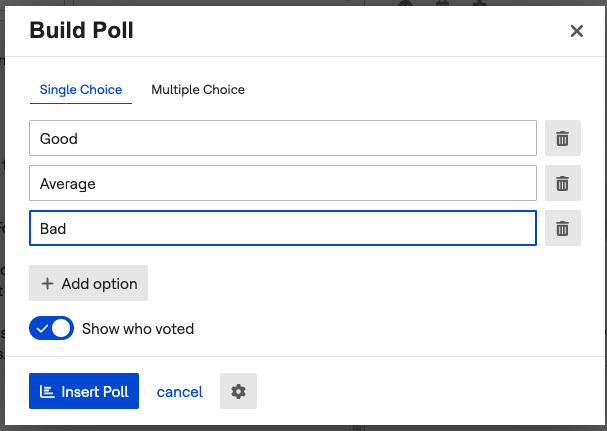Discourse has so much functionality, we’re even finding new things ourselves. Polls are one of those areas. We’ve used them internally on several occasions, but when you look beyond the immediately obvious, there’s even more power available to them.
The basics
Polls can be added to any topic to gather feedback. Just click on the cog in the editor and click “Build Poll”.
First, important to know is that to vote on the poll users need access to reply to the topic. This will apply to most categories where you can create a topic. And once people have voted, they can. remove their vote and choose a different answer.
The other useful point to know is that you can have multiple polls in a topic, as long as they have unique names.
Simple polls
The basic dialog for creating a poll gives you two poll types:
- Single choice
- Multiple choice, with option to set minimum and maximum a user can select
Besides this, you have a toggle to decide whether to capture names of who votes on what. People can view the results, and admin users can export them to CSV.
Once created, you can close the poll whenever you choose.
Advanced polls
But clicking on the cog on the dialog gives you more options.
Poll type
As well as single choice and multiple choice, you can choose:
- Number rating where users select a number in a range
- Ranked choice, where users can rank the options
Poll settings
You can also:
- Add a title to the poll
- Limit voting to groups
- Automatically close the poll after a period of time
- Decide when results should be shown
- Choose whether results should be shown in a bar chart (the default) or a pie chart
The vote is just markdown, so if you’re used to creating polls, you can do so without the poll dialog wizard.
For more, including how to add images or relative times into a poll, see this discussion topic on Discourse’s own site.

